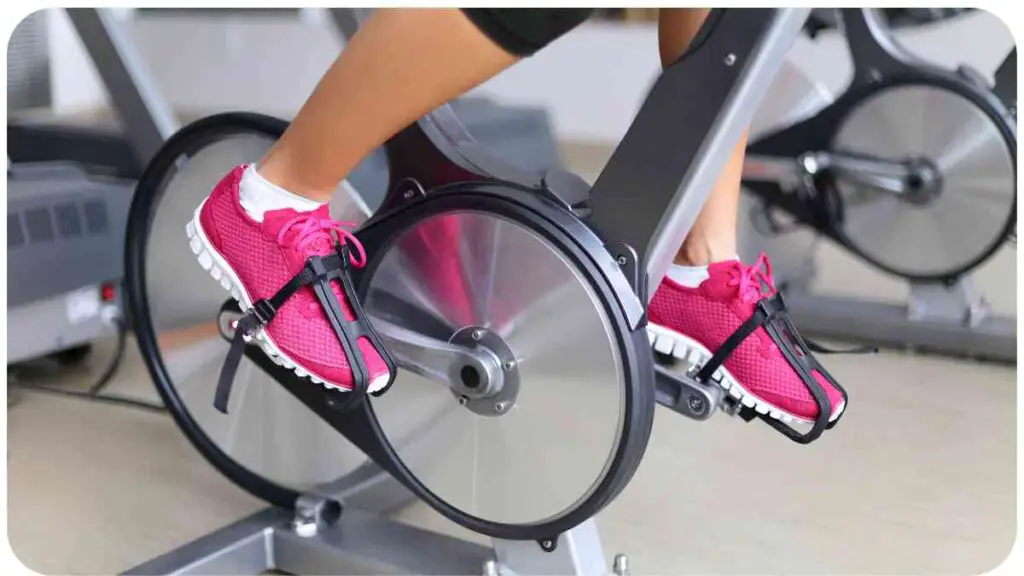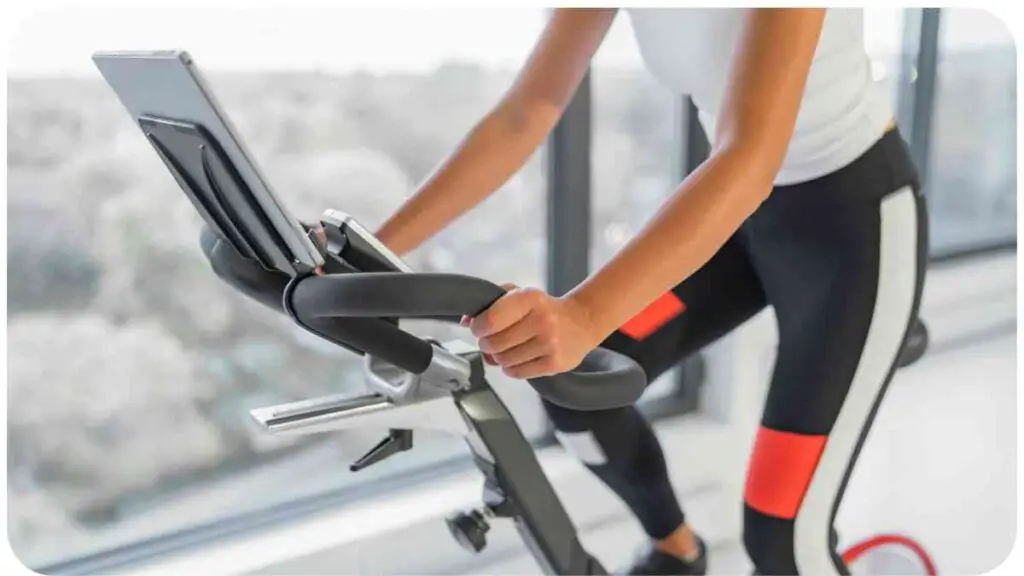Exercise bikes are a fantastic way to stay in shape and improve your cardiovascular health, but what happens when your peaceful workout is disrupted by unusual noises coming from your trusty bike? In this article, we’ll explore the common problems that can cause your exercise bike to make noise and provide you with practical solutions to silence those annoying sounds.
As a seasoned fitness professional with years of experience, I’m here to share my expertise and help you get back to your quiet, effective workout.
| Takeaways |
|---|
| Identify the source of unfamiliar exercise bike noises. |
| Lubricate, tighten, or replace affected components. |
| Regularly inspect and maintain your exercise bike. |
| Address resistance issues promptly for a better workout. |
| Ensure heart-rate grips/straps are securely fastened. |
| Understand that heart-rate monitoring provides a range. |
| Don’t ignore a slipping drive belt; tighten or replace it. |
| Check cables and power sources for console issues. |
| Professional servicing may be needed for persistent problems. |
What Causes Noise in Exercise Bikes?

Before we dive into the specific issues and their fixes, it’s essential to understand what can cause noise in exercise bikes. These machines are made up of various moving parts, and over time, wear and tear or improper maintenance can lead to unwanted sounds. Here are the common culprits:
- Pedal Noise: The pedals may creak or squeak as they rotate.
- Belt Noise: If the drive belt is worn or loose, it can create a humming or slapping noise.
- Wheel Noise: The flywheel or resistance wheel may produce sounds if not properly aligned or maintained.
Now, let’s address these issues one by one.
Exercise Bike Maintenance: If your exercise bike is making noise during workouts, it’s crucial to address it promptly. Check out our article on quick fixes to try to ensure a quieter and more enjoyable workout experience.
Unfamiliar Noises
Pedal Noise
When you start hearing odd noises from your exercise bike’s pedals, it can be quite disconcerting. These noises often result from friction between moving parts. Here’s what you can do to fix this issue:
| Problem | Solution |
| Pedal Noise | 1. Identify the source of the noise. 2. Lubricate or tighten the affected area. 3. Check pedal threading and replace if necessary. |
If the pedals are the problem, examine the threading first. Worn-out pedals that don’t sit at a 90-degree angle to the crank arm may need replacement. If the threading is cross-threaded or broken, it’s best to contact a service center like Akfit to replace the entire pedal arm.
Belt Noise
A common source of noise in exercise bikes is the drive belt. If it’s worn down or loose, you’ll likely experience a slapping sensation. Here’s how to address this issue:
| Problem | Solution |
| Belt Noise | 1. Ensure the bike is unplugged or powered off. 2. Access the belt and flywheel by removing pedals, sides, and top shields. 3. Tighten or replace the belt as needed. |
Before attempting to tighten the belt, always make sure the bike is unplugged or powered off for safety. Adjust the idler bolts and the adjustment nut to tighten the belt properly. If you’re replacing the belt, ensure you have the correct replacement part for your specific bike model. Refer to your owner’s manual or contact us at Akfit if you’re unsure about the process.
Cycling Gear Selection: Choosing the right cycling gear is essential for a comfortable ride. Our comprehensive guide on cycling gear selection will help you make informed decisions to enhance your cycling experience.
Wheel Noise
If you notice noise coming from the flywheel or resistance wheel, it’s essential to address it promptly. A wobbly resistance wheel could be the root cause. Here’s how to tackle this issue:
| Problem | Solution |
| Wheel Noise | 1. Inspect the resistance wheel for wobbling. 2. If wobbly, consider replacing the hub. |
If your exercise bike features a magnetic resistance system, the noise could be due to magnets shifting from their position because of loose bolts or screws. To fix the issue, ensure the magnets are secured properly in their designated position. If the problem persists or if you have a different resistance system, it’s advisable to contact a service center for further assistance.
Now that we’ve covered the common causes of unfamiliar noises in exercise bikes and provided initial solutions, let’s delve deeper into other potential issues and how to fix them.
Resistance Issues

When you’re using your exercise bike and notice that there’s minimal change in resistance or no resistance applied at all, it can significantly impact your workout experience. This issue often stems from problems with the resistance system. Let’s explore the potential causes and solutions.
Outdoor Adventure Essentials: Planning your next adventure? Discover the top 10 camping gears you should consider bringing along. Proper gear ensures a safe and enjoyable outdoor experience.
Cross Cabling or Bent Pins
| Problem | Solution |
| Resistance Issues | 1. Check for cross cabling or bent pins in the resistance system. 2. Address any issues found. |
Cross cabling or bent pins in the resistance system can disrupt the flow of resistance, leading to inconsistent or no resistance during your workout. Carefully inspect the cables and pins, and if you identify any problems, consider seeking professional assistance to resolve them.
Wobbly Resistance Wheel
| Problem | Solution |
| Resistance Issues | 1. Inspect the resistance wheel for wobbling. 2. Consider replacing the hub if wobbling is present. |
A wobbly resistance wheel can result in uneven resistance and unwanted noise. If you notice wobbling, it may be necessary to replace the hub to ensure smooth and consistent resistance during your workouts.
Magnetic Resistance System
| Problem | Solution |
| Resistance Issues | 1. For bikes with a magnetic resistance system, ensure magnets are securely in place. 2. Tighten loose bolts or screws. 3. Contact a service center if wiring issues are suspected. |
If your exercise bike features a magnetic resistance system, the magnets play a crucial role in providing resistance. Ensure that the magnets are firmly in position and that there are no loose bolts or screws affecting their stability. Additionally, if you suspect wiring issues related to the magnetic resistance, it’s advisable to contact a service center for professional assistance.
Essential Cooking Equipment: Building your kitchen arsenal? Explore our list of essential cooking equipment to equip your culinary adventures. The right tools make cooking a breeze.
Inconsistent Heart-Rate Readings

For many individuals, monitoring heart rate is a vital aspect of their cardio workouts. However, when your exercise bike’s heart-rate monitor provides erratic readings, it can be frustrating. Let’s explore how to address this issue.
| Problem | Solution |
| Inconsistent Heart-Rate | 1. Ensure that the heart-rate grips or straps are tightly secured to the body of the bike. 2. Understand that heart-rate monitoring provides a range, not exact measurements. |
Heart-rate monitors can provide inconsistent readings if the grips or straps are not securely fastened to the bike’s body. Double-check that they are snugly in place for accurate monitoring. It’s also essential to keep in mind that heart-rate monitoring is not an exact science; it offers a range or baseline for your heart rate rather than precise measurements.
Now that we’ve addressed issues related to resistance and heart-rate monitoring, let’s move on to another common problem with exercise bikes.
Belt Slipping
If you frequently use your exercise bike, the drive belt can wear down over time, resulting in a slipping sensation. This issue should not be ignored, as it can potentially lead to injuries. Here’s how to deal with a slipping belt.
| Problem | Solution |
| Belt Slipping | 1. Ensure the bike is unplugged or powered off. 2. Remove pedals and access the belt and flywheel. 3. Tighten the belt or replace it if necessary. |
Safety first! Always make sure your exercise bike is unplugged or powered off before attempting any maintenance. To access the belt and flywheel, remove the pedals and any protective shields. Once you have access, you can either tighten the existing belt or replace it if it’s excessively worn.
Ensure you have the correct replacement part for your specific bike model. If you’re uncertain about how to disassemble your exercise bike, consult your owner’s manual or contact a fitness equipment service center like Akfit.
Maintaining Exercise Equipment: Keep your exercise equipment in top shape with the right tools. Our article on the ultimate gardening toolkit provides insights into essential tools for maintenance. A well-maintained exercise bike ensures a quieter workout.
Display Console Not Working
The display console on your exercise bike provides valuable data for tracking your workouts. If you encounter issues with it, it can be frustrating. Let’s explore potential solutions.
| Problem | Solution |
| Display Console Not | 1. Check for loose cables within the bike. 2. Ensure the power adapter is plugged in correctly or replace the batteries. 3. Contact a fitness professional if the problem persists. |
If your exercise bike’s display console is not working correctly or fails to power on, several factors could be at play. First, inspect the internal cables to ensure they are securely connected. Secondly, check the power source—either the adapter or batteries—to ensure proper power supply. If the problem persists despite these checks, it’s advisable to contact a fitness professional for a thorough diagnosis.
Regular Maintenance for Your Exercise Bike
While addressing specific issues is essential, regular maintenance can help prevent these problems from occurring in the first place. Here are some maintenance tips to keep your exercise bike in top shape:
- Cleaning: Regularly clean the bike’s frame, pedals, and console to remove dust and sweat.
- Tighten Bolts: Periodically check and tighten bolts and screws to maintain stability.
- Lubrication: Apply lubricant to moving parts like the pedals, joints, and belt for smooth operation.
- Inspect Cables: Examine cables for wear and tear, replacing them if necessary.
- Professional Service: Consider professional servicing from experts like Akfit to ensure your bike’s longevity.
Conclusion
In conclusion, while exercise bikes can occasionally produce unwelcome noises and encounter other issues, many of these problems are fixable with a bit of knowledge and effort.
By addressing pedal, belt, and wheel noises, as well as resistance, heart-rate monitoring, and display console issues, you can maintain a quiet and effective workout environment. Additionally, regular maintenance plays a vital role in keeping your exercise bike in peak condition.
Remember that a well-maintained exercise bike not only provides a quieter experience but also ensures your safety and the longevity of your equipment. So, keep these quick fixes in mind, and enjoy your workouts in peace. If you ever need assistance or have questions about fitness equipment, don’t hesitate to reach out to us at Akfit. Happy cycling!
Further Reading
Here are some additional resources to explore for further information on exercise bike problems and solutions:
- YouTube Video: Troubleshooting Exercise Bike Issues
- Watch this video for visual guidance on troubleshooting common exercise bike problems and finding quick fixes.
- Akfit Blog: 5 Common Problems with Exercise Bikes and How to Fix Them
- Read this informative blog post from Akfit that delves into common exercise bike problems and offers detailed solutions.
- Torokhtiy Guides: Exercise Bike Problems
- Explore this guide for insights into exercise bike issues and practical tips for resolving them effectively.
FAQs
What are the common problems that exercise bikes may encounter?
Exercise bikes can face various issues, including unfamiliar noises, resistance problems, heart-rate monitor inconsistencies, belt slipping, and display console malfunctions.
How can I fix unfamiliar noises coming from my exercise bike?
To address unfamiliar noises, identify their source (e.g., pedals, belt, or wheels), and then follow specific solutions, such as lubrication, tightening, or part replacement.
What should I do if my exercise bike’s resistance is not working correctly?
If you experience resistance issues, check for cross cabling, bent pins, or a wobbly resistance wheel. Depending on the problem, you may need to address these issues or contact a service center for assistance.
Why do I get inconsistent heart-rate readings on my exercise bike?
Inconsistent heart-rate readings may occur due to loosely secured grips or straps. Make sure they are tightly fastened. Keep in mind that heart-rate monitoring provides a range, not precise measurements.
What should I do if the drive belt on my exercise bike is slipping?
If you feel the drive belt slipping, ensure the bike is powered off, then access the belt and flywheel. Tighten the belt or replace it if necessary, following safety precautions.
How can I troubleshoot a non-functional display console on my exercise bike?
To address display console issues, check for loose internal cables and ensure the power source (adapter or batteries) is properly connected. If the problem persists, seek professional assistance.

Hi! Hellen James here, I’ve been working with power tools since I was eight years old when my father took me to the hardware store and told me to pick out a tool. I ended up with a drill, and it’s been my favorite thing ever since.


